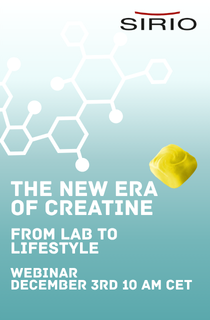Infant nutrition (part 2): Innovations in feeding the first 1,000 days
20 Jun 2018 --- Although breast milk is the most nutritious and advisable way to feed an infant for the first six months of life, as advised by the World Health Organization, there are situations that necessitate good quality breast milk substitutes. Part one of this two-part series on infant nutrition focused on the R&D challenges facing formula manufacturers. This second section focuses on the innovations in the ever-evolving market of Breast Milk Substitutes (BMS), as shared by a range of suppliers, as well as a look at the upcoming trends.
Within this space, notable innovations that have helped formulas more closely resemble human breast milk are the introduction of Milk Fat Globule Membranes (MFGM), the discovery of Human Milk Oligosaccharides (HMO) and probiotics, prebiotics, synbiotics and postbiotics.

Milk Fat Globule Membrane (MFGM)
A key beneficial component of breast milk is its unique fat component, or, MFGM. Generally, formulas did not used to contain MFGM, but derived their lipids from vegetable sources.
“If you look at the composition of human milk, the fat droplets are quite large. If you put the human milk in a glass, you would see the fat gather on top and it’s not homogenous. But in infant formula, it often is, so you don’t see the fat droplets,” Sandra Einerhand, Founder of Einerhand Science & Innovation, tells NutritionInsight. However, this is changing.
The way in which c ompanies can mimic the human milk fat droplet is extremely innovative, Einerhand adds: “not only [are they] looking at the inside of the fat droplet but also at the coating, the milk fat globule membrane. You already see companies adding this, such as Mead Johnson. Other companies are also adding it in different ways, focusing on the complex lipids present in MFGM and other companies looking at total milk fat globule insides, not just the membrane: the total fat droplet, including the coating. Some companies are adding cream, including milk phospholipids.”
ompanies can mimic the human milk fat droplet is extremely innovative, Einerhand adds: “not only [are they] looking at the inside of the fat droplet but also at the coating, the milk fat globule membrane. You already see companies adding this, such as Mead Johnson. Other companies are also adding it in different ways, focusing on the complex lipids present in MFGM and other companies looking at total milk fat globule insides, not just the membrane: the total fat droplet, including the coating. Some companies are adding cream, including milk phospholipids.”
Recently, NZMP SureStart, the global B2B pediatric ingredients brand of Fonterra, highlighted clinical findings that demonstrate the positive effect of NZMP’s SureStart MFGM Lipid100 (also known as Nuelipid) during pregnancy and on fetal brain composition.
Human Milk Oligosaccharides (HMO)
HMOs form the third most abundant solid component of human milk after lactose and fat and research increasingly demonstrates that much of breast milk's value lies within these components. HMOs have prebiotic properties and are incredibly complex to replicate.
“Composition wise, mimicking the complex human milk HMO is the goal. It’s a whole topic. A lot of companies are focusing on that and have already launched some formulas with HMO. They are further expanding that globally,” says Einerhand.
“There are over 200 specific oligosaccharides found in human breast milk. Recent developments in the ingredients sector are producing purified powders of one or two specific oligosaccharides that mimic those found in human breast milk,” Matt Cushing, Technical Innovation Lead, Pediatrics at Fonterra tells NutritionInsight.
In the future, different kinds of HMOs might become commercially available in order to be able to mimic the diversity found in human milk.
FrieslandCampina DOMO plan to offer a new product to the market later this year: “After many years of research, we are now able to produce the most abundant HMO: 2’-FL. in an identical structure to human milk available for infant nutrition,” Godert Zijlstra, Business Development Manager at FrieslandCampina tells NutritionInsight. “At the end of this year FrieslandCampina DOMO will launch 2’FL as the new ingredient for the infant nutrition market, delivering to the full infant formula customers standards.”
Furthermore, Jennewein Biotechnologie GmbH has announced its first clinical trial of an infant formula containing the five most abundant neutral and acidic HMOs at their natural concentrations, closely replicating human breast milk. The primary purpose of this trial is to confirm the nutritional suitability and tolerability of the HMO mixture for infants, which is a pre-requisite for the registration of the new product as a novel food ingredient under EU regulations.
HMOs are prebiotics that stimulate the growth of Bifidobacteria and Lactobacilli selectively. A range of manufacturers offer formula that has been enriched with HMOs, in attempts to deliver formula fed kids an equally healthy microbiome as well as the associated health benefits.
Probiotic benefits
“Fonterra offers two probiotic strains, Bifidobacterium lactis HN019 (SureStart BifidoB 019) and Lactobacillus rhamnosus HN001 (SureStart LactoB 001). Both probiotics have been extensively studied and have demonstrated several unique health benefits. BifidoB 019 has been shown to support a reduction in respiratory tract infections in infants aged 6-12 months, and when BifidoB 019 was combined with GOS, there was a reduction in a range of childhood illnesses in 1 to 3-year-old children,” says Cushing.
The prebiotic effect has also been found to protect against developing allergies: “LactoB 001 has been the subject of a long-term follow-up study, demonstrating a significant effect of long-term protection against developing eczema and a reduction in other allergenic symptoms such as hay fever or atopic sensitization. This is the first study of its kind to examine the impact of a probiotic intervention up to 11 years of age,” he adds.
Chr. Hansen also offers a probiotic strain, Bifidobacterium BB-12, one of the top two documented probiotic trains according to nearly 300 scientific publications, Charlotte Beyerholm, Senior Marketing Manager at Chr. Hansen tells NutritionInsight.
”Bifidobacteria, found in breastmilk, is known to play an important role in the development of healthy microflora in infants and children, beneficial for digestive and immune functions. Especially for infants compromised by low number of bifidobacterial which might happen if infants are born by C-section, uses antibiotics or who are not on breastmilk.”
“There are emerging studies and research indicating the possibility that changes in the intestinal flora may have played an important role in the development of food intolerances or allergies. The research indicates that moderation of the gut microbiota may help to lessen food allergies and intolerances, restoring some form of balance to the intestinal flora. Numerous clinical studies had been conducted over the years highlighting the possibility of probiotics to help decrease response to allergens in children,” she adds.
With allergies increasing amongst infants in the Western world, these innovations could be significant.
Lactobacillus rhamnosus, the world’s best documented probiotic strain, according to Chr. Hansen, will be the next prominent ingredient for infant nutrition, Beyerholm predicts.
Upcoming trends
Growing trends in infant nutrition mirror some of the big themes from the nutrition industry itself, such as diversified probiotics, organic, personalization and the gut-brain axis.
Greater innovations are coming in the line of not just pre- and probiotics but synbiotics and postbiotics: “In the last ten years the biggest breakthrough is the kno wledge about the microbiome, where many studies have shown the difference between the microbiome in a breastfed infant or a formula-fed infant. This led to prebiotics, synbiotics and postbiotics [being] added to formula in order to achieve the same effect breastfeeding does when feeding a child,” Gigi Veereman, Professor of Pediatric Gastroenterology at the Free University Brussels, tells NutritionInsight.
wledge about the microbiome, where many studies have shown the difference between the microbiome in a breastfed infant or a formula-fed infant. This led to prebiotics, synbiotics and postbiotics [being] added to formula in order to achieve the same effect breastfeeding does when feeding a child,” Gigi Veereman, Professor of Pediatric Gastroenterology at the Free University Brussels, tells NutritionInsight.
Essentially, in human milk, when you combine prebiotics and the bacteria in milk, you get synbiotics. Postbiotics are then the metabolites produced by the probiotics. “Now you see postbiotics appearing in the market in the form of a fermented infant formula produced by Danone. During fermentation the bacteria produce these postbiotics which can be beneficial for the infant,” explains Einerhand.
Secondly, the gut-brain axis focus is a particularly big focus in China, Einerhand notes. NZMP has joined Smart Lives, a five-year research program that investigates how nutrition impacts the gut-brain axis.
The move towards supplying organic formula lines is particularly salient in Western countries such as the US and UK, Einerhand states, with Roquette also adding that this is a trend to watch: “Premiumization is a key trend, we see the development of organic ranges,” Marie Blondel, Marketing Communications Manager at Roquette, tells NutritionInsight.
Personalization could also be a key trend in infant nutrition: “The use of Big Data in R&D to develop personalized infant milks is also something to look at in the near future,” Blondel, of Roquette says. However, Einerhand suggests that this may not be completely feasible in the near future. Instead, the nutrition could become more targeted, with ingredients and products directed at different infants such as C-sections born babies, boys and girls. This targeted nutrition may already qualify as personalization, others may note.
By Laxmi Haigh
















